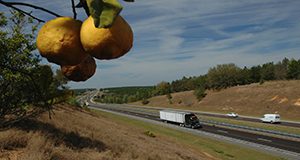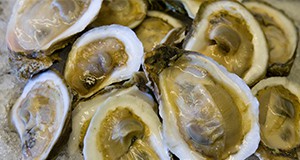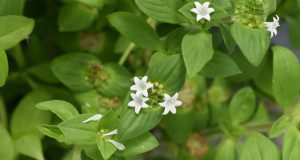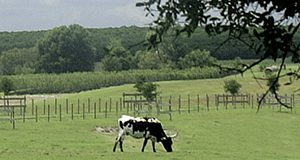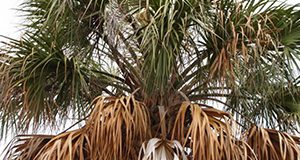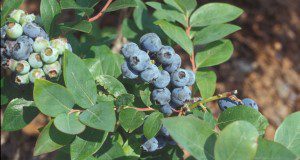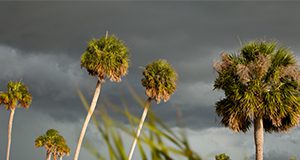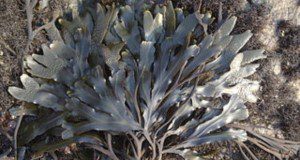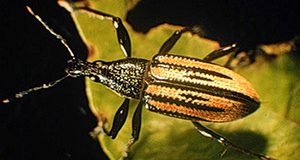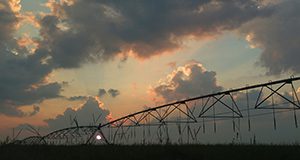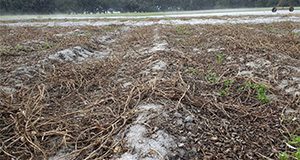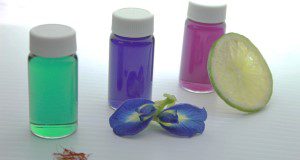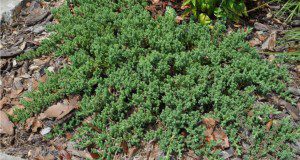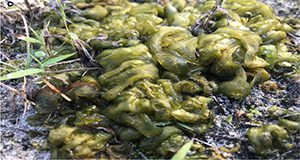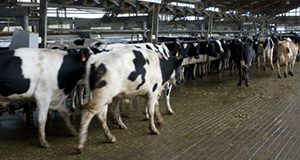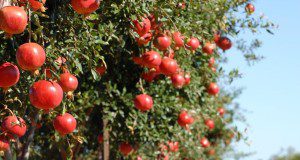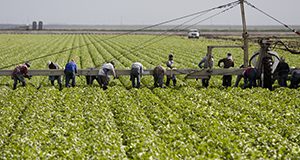El Mandato del Dispositivo de Registro Electrónico (ELD por sus siglas en ingles), se convirtió en mandato para vehículos motorizados comerciales (CMV) el 18 de diciembre del 2017. El 18 de junio del 2018, después de 90 días de extensión, el mandato también se aplicó a transportistas de productos. El propósito principal detrás del ELD fue asegurar el cumplimiento con los requerimientos de Horas de Servicio (HOS) por autotransporte y sus conductores. Este artículo se enfoca en el movimiento interestatal de propiedades (productos), and sus objetivos son: 1) revisar las reglas HOS; 2) clarificar las excepciones agrícolas a las reglas HOS; y 3) ofrecer una discusión preliminar a cómo los ELD podrían afectar a los productores del sur de Florida. Fritz Roka, Tara Wade, Luis Peña-Lévano, y Craig Sprouse. UF/IFAS Food and Resource Economics Department.
http://edis.ifas.ufl.edu/fe1058
Category: Agriculture
Tetraploid Induction and Establishment of Breeding Stocks for All-Triploid Seed Production
Triploid-tetraploid breeding technology has been applied to commercial oyster aquaculture worldwide. Triploid oysters are becoming the preferred aquaculture product because of their fast growth, better meat quality, and year-round harvest. Tetraploids are essential for triploid oyster aquaculture because commercial production of all-triploid seed depends on the availability of tetraploids for reproductive materials. This 8-page fact sheet written by Huiping Yang, Ximing Guo, and John Scarpa and published by the UF/IFAS School of Forest Resources and Conservation, Program in Fisheries and Aquatic Sciences, conveys basic knowledge about tetraploid induction and breeding to commercial shellfish culturists and the general public.
http://edis.ifas.ufl.edu/fa215
Biology and Management of Pusley (Richardia L.) in Tomato, Pepper, Cucurbit, and Strawberry Production
Four species of pusley (Richardia L.) are widespread and common weeds in Florida vegetable and strawberry production. We refer to the native plant Richardia scabra L. as Florida pusley. This discrimination is necessary because these species are often referred to collectively as Florida pusley due to overlapping distributions, similar growth habits and leaf morphologies, and difficulty identifying without the presence of fruit. This new 6-page publication of the UF/IFAS Horticultural Sciences Department describes the different pusley species and provides management options for strawberry, pepper, cucurbits, and tomato. Written by Shaun M. Sharpe, Nathan S. Boyd, Chris Marble, and Shawn Steed.
https://edis.ifas.ufl.edu/hs1331
Methods to Relieve Heat Stress for Florida Dairies
The hot and humid weather in Florida affects dairy cattle performance throughout the year, and producers who hope to achieve optimum production from their dairy cows must provide them with relief from heat and humidity. This 4-page fact sheet written by I. M. Toledo, G. E. Dahl, R. A. Bucklin, and D. K. Beeke and published by the UF/IFAS Department of Agricultural and Biological Engineering describes several cooling strategies to alleviate heat stress in dairy cattle.
http://edis.ifas.ufl.edu/ae022
Lethal Bronzing Disease (LBD)
Lethal bronzing disease (LBD), formerly Texas Phoenix Palm Decline (TPPD), is a lethal phytoplasma infection of various palm species in the state of Florida. It was first detected in Florida in 2006 and has since spread to 31 different counties and been isolated from 16 different species of palm. This three-page fact sheet describes the pathogen and hosts of LBD, its symptoms, how to diagnose it, and disease management practices. Written by Brian W. Bahder and Ericka Helmick and published by the UF/IFAS Plant Pathology Department, this article is a revision of an earlier fact sheet by Nigel A. Harrison and Monica L. Elliott.
https://edis.ifas.ufl.edu/pp163
Florida Blueberry Leaf Disease Guide
Southern highbush blueberry (SHB) cultivars are commercially grown throughout much of Florida, in both deciduous and evergreen production systems. In both systems, leaves can be damaged by many factors including environmental conditions, chemical applications, insects, and diseases. This new 12-page publication of the UF/IFAS Plant Pathology Department includes basic information to assist growers in determining 1) the likely cause (fungal, viral, algal, or bacterial) of leaf symptoms, 2) when specific leaf spots are likely to occur, 3) characteristic symptoms of common leaf problems, and 4) some of the management options that are available. Written by Douglas A. Phillips, Norma C. Flor, and Philip F. Harmon.
http://edis.ifas.ufl.edu/pp348
An Overview of Risk Management Planning
As risks evolve and diversify, approaches to conducting business require a targeted focus on risk management, particularly in agriculture. This new 3-page document explores risk in agriculture, the need to understand risk, formation of strategies to manage risk, and government programs that exist to help growers and producers manage risk. Written by Martie Gillen and Beatrice Pierre, and published by the UF/IFAS Department of Family, Youth and Community Sciences, May 2019.
http://edis.ifas.ufl.edu/fy1482
Estasyon Meteyo nan Jaden: Gid pou Enstalasyon ak Antretyen
Kondisyon meteyo yo ka jwe yon gwo wòl nan siksè oswa echèk aktivite agrikòl yo. Kiltivatè yo rekonèt sa e se sak fè yo toujou swiv bilten ak previzyon meteyo pou ka ede yo pran desizyon nan sa ki gen pou wè ak irigasyon, pwoteksyon kont fredi ansanm ak anpil lòt desizyon. This new 4-page publication is the Haitian Creole version of EDIS document AE532, Guidelines for Establishing and Maintaining Farm-Based Weather Stations in Haiti. Written by Caroline G. Staub, William Eisenstadt, William Blanc, Nicole Monval, Clyde W. Fraisse, William Lusher, George Braun, and Lee Staudt, and published by the UF/IFAS Department of Agricultural and Biological Engineering, May 2019.
http://edis.ifas.ufl.edu/ae531
Guidelines for Establishing and Maintaining Farm-Based Weather Stations in Haiti
Weather can significantly influence the success or failure of agricultural enterprises. Monitoring weather conditions can provide critical decision-making information. This new 4-page publication provides Haitian farmers with basic guidelines for installing and maintaining an on-farm weather station. Written by Caroline G. Staub, William Eisenstadt, William Blanc, Nicole Monval, Clyde W. Fraisse, William Lusher, George Braun, and Lee Staudt, and published by the UF/IFAS Department of Agricultural and Biological Engineering, May 2019.
http://edis.ifas.ufl.edu/ae532
Plant Biostimulants: Definition and Overview of Categories and Effects
This new 4-page article provides an overview of a group of crop production materials termed “plant biostimulants,” which are frequently promoted as environment-friendly alternatives to chemical-based products. It explains their regulatory status and presents an overview of the most popular materials (e.g., beneficial fungi, seaweeds, and silicon) and their effects on plants. Written by Ute Albrecht and published by the UF/IFAS Horticultural Sciences Department.
http://edis.ifas.ufl.edu/hs1330
Diaprepes Root Weevil on Southern Highbush Blueberry in Florida
Citrus root weevil, Diaprepes abbreviatus (Linnaeus) is a destructive pest on citrus trees. It is now becoming a significant pest on blueberry in central Florida, at times causing major damage to blueberry bushes that are more than two years old. This 3-page fact sheet written by Douglas A. Phillips, Oscar E. Liburd, and Larry W. Duncan and published by the UF/IFAS Entomology and Nematology Department will educate blueberry growers on how to monitor, identify, and control citrus root weevil.
http://edis.ifas.ufl.edu/in1241
Valuing Florida Water Resources: Water Use in Irrigated Agriculture
Water resources provide us with a variety of goods and services (altogether often referred to as ecosystem services or environmental services.) Part of a series entitled Economic Value of Florida Water Resources, this 5-page fact sheet written by Tatiana Borisova, Syed Irfan Ali Shah, Tara Wade, Kelly Grogan, and Xiang Bi and published by the UF/IFAS Food and Resource Economics Department assesses the economic value of the ecosystem services provided by irrigation water and shows the importance to agriculture of water resource protection and restoration.
http:edis.ifas.ufl.edu/fe1057
Nitrogen Contributions from Peanut Residues to Subsequent Crops
There is not enough evidence to support current peanut N credit recommendations in the Southeast. Nitrogen is released rapidly from peanut residues, and it moves quickly through light-textured soils found in this region. Only a relatively small amount of N from peanut residues is available when subsequent crops need it. This new 5-page document discusses peanut nitrogen credits, nitrogen release from peanut residues, crop performance following peanut, tillage and nitrogen release, and peanut residue distribution and nitrogen release. Written by Arun Jani and Michael J. Mulvaney, and published by the UF/IFAS Agronomy Department, April 2019.
http://edis.ifas.ufl.edu/ag431
Butterfly Pea (Clitoria ternatea) Flower Extract (BPFE) and Its Use as a pH-Dependent Natural Colorant
Butterfly pea (Clitoria ternatea), a twining vine native to Southeast Asia, produces deep blue to purple flowers that bloom nearly year-round in ideal conditions. When extracted in a liquid, the addition of a mild acid such as lemon or lime juice turns the naturally deep blue to purple color into a much lighter pink or purple color, giving the extract its color-changing ability. This new 5-page publication of the UF/IFAS Environmental Horticulture Department outlines the use of butterfly pea flower extract (BPFE) as a pH-dependent natural colorant, including an explanation of the science behind the color change, detailed parameters for flower extraction, instructions for storage and processing of the extract as well as a discussion of some of the other benefits of using BPFE. Written by Sean Michael Campbell and Brian Pearson.
http://edis.ifas.ufl.edu/ep573
Key Plant, Key Pests: Juniper (Juniperus spp.)
This series of Key Plant, Key Pests publications is designed for Florida gardeners, horticulturalists, and landscape professionals to help identify common pests associated with common Florida flora. This seven-page publication, the ninth in the Key Plant, Key Pests series, helps identify the most common pests found on Juniper, with information and general management recommendations for bagworms, eriophyid mites, scale, spider mites, webworm, mushroom root rot, needle blight, Rhizoctonia web blight, tip blight, and wet root rot diseases. Written by Juanita Popenoe, Jacqueline Bourdon, Caroline R. Warwick, and Alfred Huo and published by the UF/IFAS Environmental Horticulture Department.
http://edis.ifas.ufl.edu/ep570
Biologia y Manejo de Nostoc (Cyanobacteria) en Viveros y Invernadores
Este artículo es escrito para ayudar el lector a entender la biología y ecología de Nostoc, un género común de cianobacteria (alga verdeazulada) de suelos húmidos, y proporcionar métodos para manejar esta plaga en viveros. This 4-page document is the Spanish version of Biology and Management of Nostoc (Cyanobacteria) in Nurseries and Greenhouses. Written by H. Dail Laughinghouse IV, David E. Berthold, Chris Marble, and Debalina Saha, and published by the UF/IFAS Agronomy Department, April 2019.
http://edis.ifas.ufl.edu/ag432
How Are Cows Cooled on Dairy Farms in Florida?
While hot and humid conditions cause grief for dairy producers, additional impacts of heat and humidity on the dairy cow are sometimes overlooked. These conditions and their associated losses in productivity pose a growing concern to dairy producers, as more frequent and severe fluctuations in temperature, precipitation, and droughts are predicted to occur in the United States. This new 4-page document discusses heat stress in the dairy industry, the Florida dairy heat stress abatement survey, and heat stress abatement for lactating cows, dry cows, and dairy calves. Written by Bethany Dado-Senn, Geoffrey E. Dahl, and Jimena Laporta, and published by the UF/IFAS Department of Animal Sciences, April 2019.
http://edis.ifas.ufl.edu/an355
La Granada en Florida: Una fruta de arbol para Florida?
El potencial económico en la producción comercial para el cultivo de granadas en Florida es actualmente desconocido en este momento. La investigación científica continúa sobre la posibilidad de encontrar variedades de granadas que puedan crecer en Florida. Las condiciones ambientales, con una alta temporada húmeda en la Florida, y un clima caluroso, son factores que son favorables para las enfermedades en las granadas y eso reduce la calidad de esta fruta, especialmente para las variedades de temporada tardía como la variedad ‘Wonderful’. ‘Wonderful’ es el principal cultivar comercial que se originó en la Florida. Para reducir las enfermedades y evitar la competencia de comercialización con las granadas de California, la investigación para la producción de granadas en la Florida debe centrarse en buscar variedades de temporada temprana que puedan cosecharse en julio y agosto. This six-page document is the Spanish translation of HS44, The Pomegranate. Written by Ali Sarkhosh and Jeff Williamson, translated by Eva Pabon, and published by the UF/IFAS Horticultural Sciences Department.
http://edis.ifas.ufl.edu/hs294
Food Safety on the Farm: Good Agricultural Practices and Good Handling Practices: an Overview
Good Agricultural Practices (GAPs) and Good Handling Practices (GHPs) encompass the general procedures that growers, packers and processors of fresh fruits and vegetables should follow to ensure the food safety of their product. GAPs usually deal with preharvest practices (i.e., in the field), while GHPs cover postharvest practices, including packing and shipping. We will use the term GAPs in this fact sheet to generally cover pre- and postharvest practices associated with the safe handling of produce, both fresh and minimally processed. This five-page introduction to the Food Safety on the Farm series provides an overview of GAPs and GHPs, summarizing major principles and recommendations of later documents in the series. Written by Jaysankar De, Christopher R. Pabst, Jessica Lepper, Renée Goodrich Schneider, and Keith R. Schneider and published by the UF/IFAS Food Science and Human Nutrition Department.
http://edis.ifas.ufl.edu/fs135
Protecting Perishable Foods During Transport by Truck and Rail
The importance of protecting perishable foods from loss of quality during transport has long been recognized. Increased recognition of the importance of the transport link in the food distribution cold chain in securing the safety of perishable foods has more recently become as well recognized.
This updated edition reflects the dynamic changes and innovations in the handling and transportation of perishable foods. Some of these include improved insulation and air movement, microprocessors for more efficient refrigeration, expert systems to control the transport environment and conserve fuel energy, and the use of telematics to monitor and control the performance of refrigerated vehicles during transit. This edition includes descriptions and recommendations for food transported over the road and by rail in marine containers, as well as in railcars. This 214-page revision was written by J. K. Brecht, Steven A. Sargent, Patrick E. Brecht, Jorge Saenz, and Leonard Rodowick and published by the UF/IFAS Horticultural Sciences Department in cooperation with the USDA AMS Transportation Services Division.
http://edis.ifas.ufl.edu/hs1328
